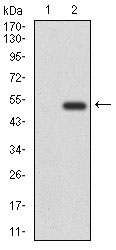CD6 Antibody
Purified Mouse Monoclonal Antibody
- 产品详情
- 实验流程
Application
| WB, IHC, E |
|---|---|
| Primary Accession | P30203 |
| Reactivity | Human |
| Host | Mouse |
| Clonality | Monoclonal |
| Clone Names | 6B9 |
| Isotype | IgG1 |
| Calculated MW | 71801 Da |
| Description | This gene encodes a protein found on the outer membrane of T-lymphocytes as well as some other immune cells. The encoded protein contains three scavenger receptor cysteine-rich (SRCR) domains and a binding site for an activated leukocyte cell adhesion molecule. The gene product is important for continuation of T cell activation. This gene may be associated with susceptibility to multiple sclerosis (PMID: 19525953, 21849685). Multiple transcript variants encoding different isoforms have been found for this gene. |
| Immunogen | Purified recombinant fragment of human CD6 (AA: 472-668) expressed in E. Coli. |
| Formulation | Purified antibody in PBS with 0.05% sodium azide |
| Gene ID | 923 |
|---|---|
| Other Names | T-cell differentiation antigen CD6, T12, TP120, CD6, CD6 |
| Dilution | WB~~1/500 - 1/2000 IHC~~1/200 - 1/1000 E~~1/10000 |
| Storage | Maintain refrigerated at 2-8°C for up to 6 months. For long term storage store at -20°C in small aliquots to prevent freeze-thaw cycles. |
| Precautions | CD6 Antibody is for research use only and not for use in diagnostic or therapeutic procedures. |
| Name | CD6 (HGNC:1691) |
|---|---|
| Function | Cell adhesion molecule that mediates cell-cell contacts and regulates T-cell responses via its interaction with ALCAM/CD166 (PubMed:15048703, PubMed:15294938, PubMed:16352806, PubMed:16914752, PubMed:24584089, PubMed:24945728). Contributes to signaling cascades triggered by activation of the TCR/CD3 complex (PubMed:24584089). Functions as a costimulatory molecule; promotes T-cell activation and proliferation (PubMed:15294938, PubMed:16352806, PubMed:16914752). Contributes to the formation and maturation of the immunological synapse (PubMed:15294938, PubMed:16352806). Functions as a calcium- dependent pattern receptor that binds and aggregates both Gram-positive and Gram-negative bacteria. Binds both lipopolysaccharide (LPS) from Gram-negative bacteria and lipoteichoic acid from Gram-positive bacteria (PubMed:17601777). LPS binding leads to the activation of signaling cascades and down-stream MAP kinases (PubMed:17601777). Mediates activation of the inflammatory response and the secretion of pro-inflammatory cytokines in response to LPS (PubMed:17601777). |
| Cellular Location | Cell membrane; Single-pass type I membrane protein. Note=Detected at the immunological synapse, i.e, at the contact zone between antigen-presenting dendritic cells and T-cells (PubMed:15294938, PubMed:16352806). Colocalizes with the TCR/CD3 complex at the immunological synapse (PubMed:15294938) |
| Tissue Location | Detected on thymocytes (PubMed:15294938). Detected on peripheral blood T-cells (PubMed:15048703, PubMed:16352806) Detected on natural killer (NK) cells (PubMed:16352806). Soluble CD6 is detected in blood serum (at protein level) (PubMed:17601777). Detected in spleen, thymus, appendix, lymph node and peripheral blood leukocytes (PubMed:9013954). Expressed by thymocytes, mature T-cells, a subset of B-cells known as B-1 cells, and by some cells in the brain |
Research Areas
For Research Use Only. Not For Use In Diagnostic Procedures.
Application Protocols
Provided below are standard protocols that you may find useful for product applications.
REFERENCES
1.J Autoimmun. 2010 Dec;35(4):336-41.2.Proc Natl Acad Sci U S A. 2007 Jul 10;104(28):11724-9.
终于等到您。ABCEPTA(百远生物)抗体产品。
点击下方“我要评价 ”按钮提交您的反馈信息,您的反馈和评价是我们最宝贵的财富之一,
我们将在1-3个工作日内处理您的反馈信息。
如有疑问,联系:0512-88856768 tech-china@abcepta.com.























 癌症的基本特征包括细胞增殖、血管生成、迁移、凋亡逃避机制和细胞永生等。找到癌症发生过程中这些通路的关键标记物和对应的抗体用于检测至关重要。
癌症的基本特征包括细胞增殖、血管生成、迁移、凋亡逃避机制和细胞永生等。找到癌症发生过程中这些通路的关键标记物和对应的抗体用于检测至关重要。 为您推荐一个泛素化位点预测神器——泛素化分析工具,可以为您的蛋白的泛素化位点作出预测和评分。
为您推荐一个泛素化位点预测神器——泛素化分析工具,可以为您的蛋白的泛素化位点作出预测和评分。 细胞自噬受体图形绘图工具为你的蛋白的细胞受体结合位点作出预测和评分,识别结合到自噬通路中的蛋白是非常重要的,便于让我们理解自噬在正常生理、病理过程中的作用,如发育、细胞分化、神经退化性疾病、压力条件下、感染和癌症。
细胞自噬受体图形绘图工具为你的蛋白的细胞受体结合位点作出预测和评分,识别结合到自噬通路中的蛋白是非常重要的,便于让我们理解自噬在正常生理、病理过程中的作用,如发育、细胞分化、神经退化性疾病、压力条件下、感染和癌症。









